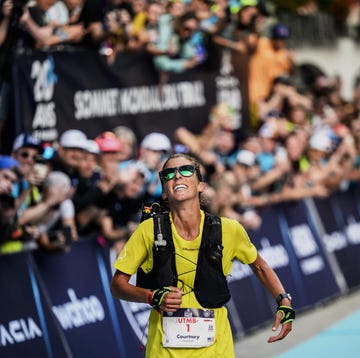It’s official: running and dating are now an item.
Nowhere is this more apparent than at the Tinder SoleMates Run Club, a collaboration with running app Runna designed to bring singles together for an on-the-move dating experience. If running and dating seem unlikely bedfellows, it’s worth bearing in mind that the term “running” currently ranks as one of the top Tinder profile tagged interests. Similarly, mention of “parkrun” in users’ bios has increased by 90% in the period between March 2023 and Match 2025. The latest research by Tinder provides further context for the run-date phenomenon. It found that 29% of Gen Z singles ‘feel more confident on activity-based dates’, with 45% of young singles saying that ‘traditional dates feel more like a job interview’. Thirty-nine per cent of singles admit they’ve pretended to be sporty to impress a date, however, so it might be worth checking their Power of 10 before swapping numbers.
What’s the perfect running pace for a date?
In an attempt to find the magic pace for the run date, Tinder asked Andrew Jones, professor of applied physiology at the University of Exeter, to look into the data. Tinder, somewhat toe-curlingly, defines this perfect pace as ‘the sweet spot that helps runners look cool, feel confident and keep the flirty vibes flowing’. And that number is…12.1 minutes per mile.
What everyone's reading
Professor Jones explains that the moderate 12.1 minutes per mile (7.5 minutes per kilometre) keeps the heart rate elevated enough to release feel-good endorphins, without pushing the body into stress mode or causing excessive sweating – rarely a great look on a first date.
The research, which surveyed 2,000 UK singles aged 18-35, also found that authenticity is a key factor when forming connections both online and IRL (that’s ‘in real life’, gramps). More than 70% of people said they wanted to ‘show up as their unfiltered selves right from the start’. Connected to this, 38% said they preferred an activity date to grabbing a pint.
However, not everyone’s on board with the run-date. In fact, more than half of millennials say they’re hesitant to go on a fitness date in case they fail to make a good impression.
Speaking about the data, Professor Jones said: ‘Tinder’s data shows that more young singles are prioritising their wellbeing than ever before, and with the running season in full swing, it’s the perfect time to rethink what a first date can look like. Running lifts your mood, builds confidence, and when you get the pace just right, it creates the perfect conditions for genuine connection.’
How ‘date pace’ was established
It’s fair to say that when attempting to identify the optimum ‘date pace’, Professor Jones and co didn’t employ a watertight level of scientific rigour. The idea was to find a pace ideal for people going on a 5K run date – one that allows them to have a conversation without getting too out of breath.
To this end, the researchers looked at average parkrun finish times. They assumed ‘the kind of people who would sign up for a singles dating 5K would be fairly similar to parkrun participants in terms of age and fitness levels’ – something that may or may not be true, of course.
Based on parkrun stats, most people finish a 5K in 32 to 36 minutes. For men aged 20-30, the average time is 29 minutes; for women of the same age demographic, it’s 36 minutes. The researchers assumed (probably fairly) that most people would want their ‘date pace’ to be a little more relaxed than their parkrun time. And since a date, by definition, includes at least two people, then the pace should match that of the slower runner.
This all meant that the average parkrun time of around 11 minutes per mile (7 minutes per kilometre) was relaxed down to 12.1 minutes per miles (7.5 minutes per kilometre).
So, at best, ‘date pace’ is just an estimate. Faster and slower paces can still, presumably, lead to sparks flying. But if you’re holding forth while your dates gasps alongside you, don’t assume it’s a response to your breathtaking banter. You might just need to slow down.













